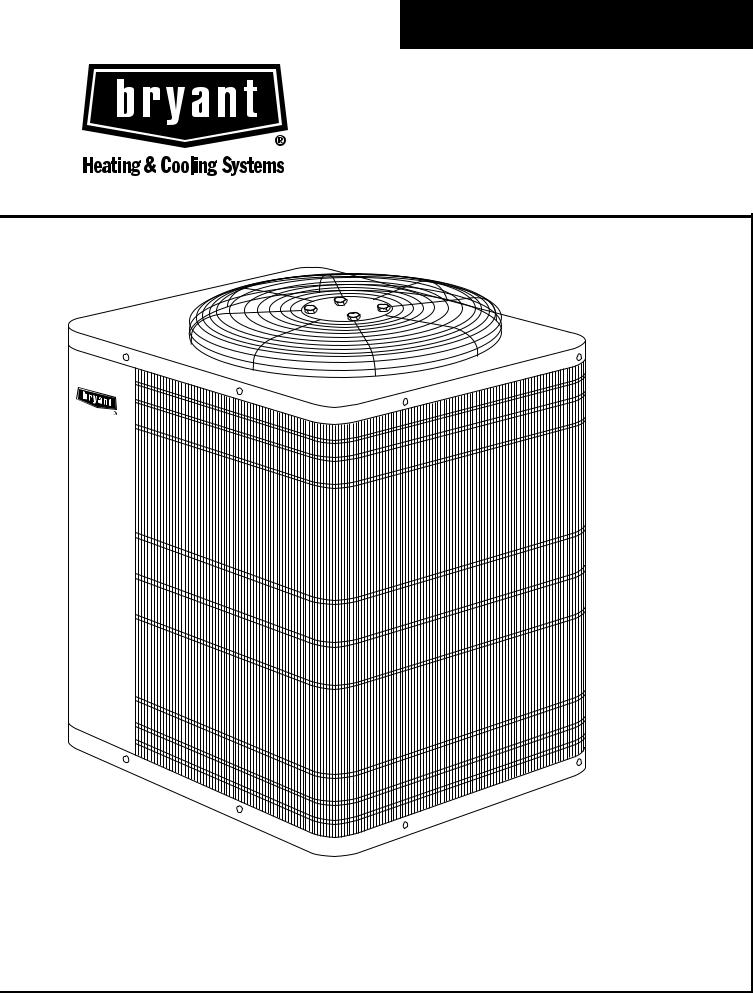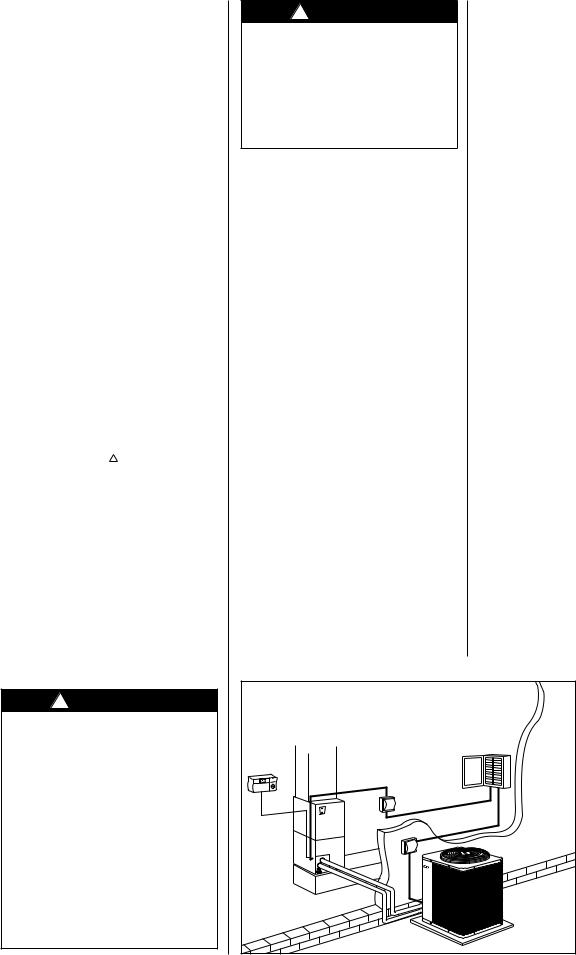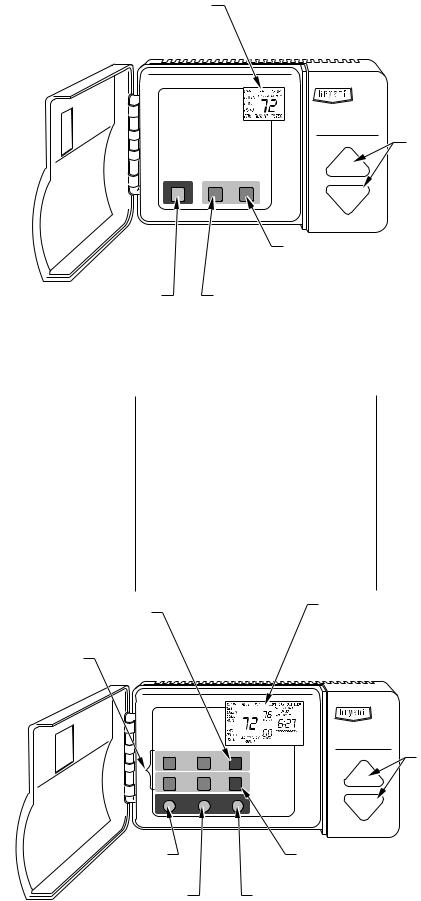Bryant Quantum Plus CENTRAL AIR CONDITIONER User Manual

USER’S INFORMATION MANUAL
CENTRAL AIR
CONDITIONER
NOTE TO
INSTALLER:
This manual
must be left with the
equipment user.

WELCOME TO EFFICIENT HOME COOLING COMFORT
Congratulations on your excellent choice and sound investment in home cooling comfort!
Your new air conditioning unit represents the culmination of many years of experience from one of the most reputable manufacturers of comfort systems.
Your new unit is among the most reliable and energy-efficient air conditioning products available today. To assure its dependability, spend just a few minutes with this booklet now. Learn about
the operation of your air conditioner, and the small amount of maintenance it takes to keep it operating at its peak efficiency.
With minimal care, your new air conditioner will provide you and your family with cool comfort—both now and for years to come.
SAFETY
CONSIDERATION
Recognize safety information. This is the safety-alert symbol ! . When you see this symbol on the unit or in instructions and manuals, be alert to the potential for personal injury.
Understand the signal word DANGER, WARNING, or CAUTION. These words are used with the safety-alert symbol.
DANGER identifies the most serious hazards which will result in severe personal injury or death. WARNING signifies hazards that could result in personal injury or death. CAUTION is used to identify unsafe practices which would result in minor personal injury or product and property damage.
! WARNING
Improper installation, adjustment, alteration, service, maintenance, or use can cause explosion, fire, electrical shock, or other conditions which may cause personal injury or property damage. Consult a qualified installer, service agency, or your distributor or branch for information or assistance. The qualified installer or agency must use factory-authorized kits or accessories when modifying this product.
! WARNING
To prevent personal injury, death, or property damage, read and follow all instructions and warnings, including labels shipped with or attached to unit before operating your new air conditioner.
YOUR COMFORT
SYSTEM
Identifying Your System
Take time to get to know the type of system you have. This will be helpful in understanding the basic operation of your new air conditioner.
The split-system type has an indoor and an outdoor unit, each of which contains a coil. These units are interconnected by refrigerant tubes. (See Fig. 1.)
Each unit has a rating plate affixed to it which provides necessary information for specific identification of a unit. You should familiarize yourself with the product, model, and serial numbers listed on each rating plate. Record them for future reference on last page of this booklet.
IMPORTANT FACTS
To better protect your investment and to eliminate unnecessary service calls, familiarize yourself with the following facts:
• Keep Filter Clean
Your air conditioning system should never be operated without a properly installed, clean air filter. Plan to inspect the filter periodically. A clogged air filter will
increase operating costs and shorten the life of the unit.
• Do Not Block Registers
Supply-air and return-air registers should not be blocked. Drapes, furniture, and toys are some of the items commonly found obstructing registers. Restricted airflow lessens the unit’s efficiency and life span.
• Do Not Cover or Block Outdoor Unit
The outdoor unit must have unrestricted airflow. Do not cover the unit, lean anything against it, or stand on it. Do not allow grass clippings, leaves, or other debris to accumulate around or on top of the unit. Maintain a 12-in. minimum clearance between the outdoor unit and tall grass, vines, shrubs, etc.
• Get To Know Your Thermostat
Your multipurpose indoor thermostat is the control center for your air conditioning system. You should familiarize yourself with its proper operation. Attempting to control the system by other means—for instance, switching the electrical supply power ON and OFF— may cause damage to the unit.
Thermostat “jiggling” causes rapidcycling, which is potentially damaging to the compressor. Do not move the temperature selector on the thermostat for any reason for at least 5 minutes after the compressor has shut off.
• Continuous Fan
You may find that you can maintain greater personal comfort by running the fan continuously. Air pockets can form due to the structure of the house, placement of registers, etc. These air pockets may be too cool or warm for your liking. Continuous fan operation minimizes temperature differences.
Fig. 1—
Typical
Split-
System
Installation
2

LCD READOUT DISPLAYS CURRENT ROOM TEMPERATURE, DESIRED ROOM TEMPERATURE, UNIT MODE SETTING, AND FAN MODE SETTING
Thermostat
RESET/FILTER |
FAN |
MODE |
UP AND DOWN BUTTONS INCREASE OR DECREASE THE
DESIRED TEMPERATURE SETTINGS
|
MODE BUTTON SELECTS |
|
BETWEEN OFF, HEAT, |
|
COOL, AND AUTO OPERATION |
RESET FILTER BUTTON |
FAN BUTTON CHOOSES |
RESTARTS THE TIMER |
BETWEEN ON OR AUTO |
THAT CALCULATES |
FAN OPERATION |
THE NEXT AIR FILTER |
|
CHANGE OR CLEANING |
|
Fig. 2—Bryant Non-Programmable Thermostat
• Air Cleaners and Humidifiers
Systems equipped with electronic or mechanical air cleaners and/or humidifiers offer the added benefits of having the air continuously cleaned year-round, and humidified during the winter season.
• Ventilation
A system equipped with a heat or energy recovery ventilator offers the advantage of exhausting stale air from the home and allowing fresh air in from the outdoors while minimizing heat loss.
• Zoning
Your system may also be equipped with a zoning system which allows individual control over the temperatures of separate areas of your home.
• Check Condensate Drain
Your air conditioner will remove humidity from your home during the cooling season. After a few minutes of operation, you should be able to see water trickle from the condensate drain of the cooling coil. Check this occasionally to be sure the drain system is not clogged. Of course,
don’t expect to see much drainage if you live in a very dry environment.
• When Not To Use Your Unit
Do not operate your unit when outdoor temperatures are below 55°F.
OPERATING YOUR AIR CONDITIONER
The operation of your air conditioning system is controlled by the indoor thermostat. You simply adjust the thermostat and it maintains the indoor temperature at
MODE BUTTON SELECTS
BETWEEN OFF, HEAT, COOL,
AND AUTO OPERATION
PROGRAM BUTTONS
FOR PROGRAMMING
HEATING/COOLING
CYCLES
Programmable |
|
|
Thermostat |
|
|
COPY PREVIOUS DAY |
PROGRAM |
MODE |
CHANGE DAY |
END |
FAN |
SET TIME/TEMP |
RESET FILTER |
HOLD |
LCD READOUT DISPLAYS
CURRENT ROOM TEMPERATURE,
DESIRED ROOM TEMPERATURE
OR OUTDOOR TEMPERATURE,
UNIT MODE SETTING,
FAN MODE SETTING,
AND TIME OF DAY
UP AND DOWN
BUTTONS INCREASE
OR DECREASE THE
DESIRED TEMPERATURE
SETTINGS
SET TIME |
FAN BUTTON CHOOSES |
BUTTON |
BETWEEN ON OR AUTO |
|
FAN OPERATION |
RESET FILTER BUTTON |
HOLD BUTTON MAINTAINS |
RESTARTS THE TIMER |
THE CURRENT TEMPERATURE |
THAT CALCULATES |
AND OVERRIDES PROGRAMMED |
THE NEXT AIR FILTER |
TEMPERATURE CHANGES |
CHANGE OR CLEANING |
UNTIL RESET |
Fig. 3—Bryant Programmable Thermostat
3
